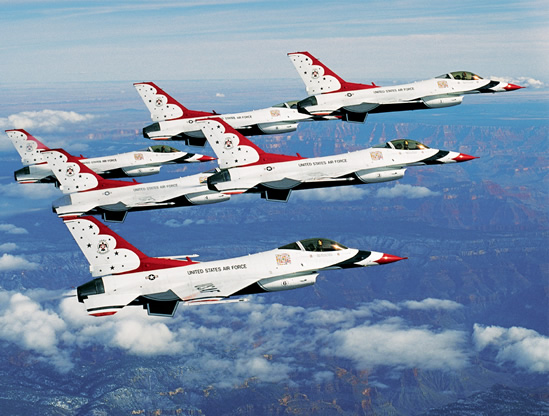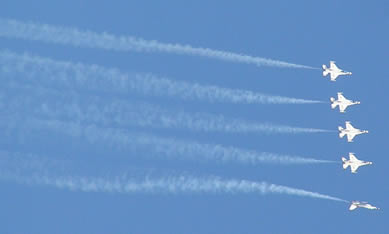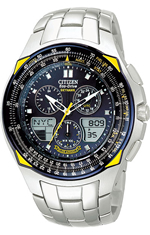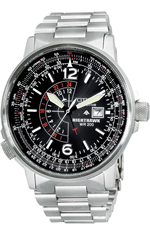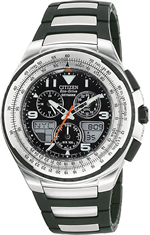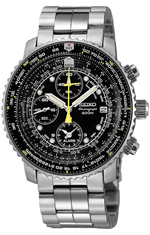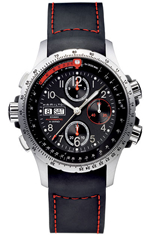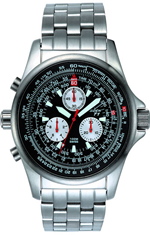In 1947, while the jet age was still in its infancy, military aviation was hurtled into the future with the creation of the U.S. Air Force as a separate service. Just six years later, on May 25, 1953, the Air Force’s official air demonstration team, designated the 3600th Air Demonstration Unit, was activated at Luke Air Force Base, Arizona.
The name “Thunderbirds” was soon adopted by the unit; influenced in part by the strong Indian culture and folklore of the southwestern United States where Luke is located. Indian legend speaks of the Thunderbird with great fear and respect. To some it was a giant eagle … others envisioned a hawk. When it took to the skies, the earth trembled from the thunder of its great wings. From its eyes shot bolts of lightning. Nothing in nature could challenge the bird of thunder, the story said, and no man could stand against its might. The story of the Thunderbird was repeated, voice-by-voice, across the generations, until at last, it assumed the immortality of legend.
A more appropriate name couldn't have been selected, as it is with the same commanding presence the Thunderbirds took to the skies.
Seven officers and 22 enlisted were selected for the first demonstration team, most were handpicked from the cadre at Luke.
Maj. Dick Catledge, a training squadron commander at Luke, was chosen as the team’s leader. Twins Bill and Buck Patillo were selected and would fly left and right wing, respectively. The Patillo's, both captains, were ideal choices as both had been with the “SkyBlazers”, a USAF/Europe demonstration team, for the past 3 years. For the difficult position of slot, the position sandwiched between both wingmen and behind the leader, Capt. Bob Kanaga was selected, an instructor at Luke. The spare pilot would be Capt. Bob McCormick. Like the Patillo brothers, he also had demonstration team experience, having flown right wing with the “Sabre Dancers,” a predecessor to the Thunderbirds. 1st Lt. Aubrey Brown would serve as maintenance officer for the team. He, with his senior enlisted man, MSgt. Earl Young, selected 21 enlisted men to help maintain the team’s aircraft. Capt. Bill Brock was the final officer selected for the team serving as the information services officer and team narrator.
From these humble beginnings and this group of men, the Air Force Thunderbird legend was born.
The first aircraft selected for the new demonstration team was the straight wing F-84G Thunderjet built by Republic Aviation. Their straight wing configuration was considered well suited for aerobatic maneuvers, and although the aircraft could not exceed the speed of sound, like some military aircraft, it easily met the needs of a demonstration aircraft.
The original demonstration sequence consisted of a series of formation aerobatics lasting 15 minutes. The spare pilot took-off a few minutes in advance of the Diamond to run a weather check, advise of any encroaching traffic, reiterate the location of obstructions and then landed to be used as a spare aircraft. As the season progressed, the opportunity was utilized to perform ‘solo’ maneuvers with the spare aircraft while the Diamond burned off fuel and repositioned out of sight of the crowd.
Mindful of their mission to show the Air Force’s best aircraft, the Air Force selected the swept wing F-84F Thunderstreak as their second aircraft in 1955. The Thunderstreak was modified for the team by adding smoke tanks for the first time, and red, white and blue drag chutes.
With the move from the F-84F to the F-100 Super Sabre in 1956, the Thunderbirds became the world’s first supersonic aerial demonstration team. That same year, the Thunderbirds moved to Nellis Air Force Base, Nevada, simplifying logistics and maintenance for the aircraft.
Although never a routine part of the Thunderbird show in 1956, the solo would fly supersonic at the request of the air show sponsor. Eventually, the Federal Aviation Authority, a precursor to the Federal Aviation Administration, banned all supersonic flight at air shows and consequently, today’s sequence is entirely subsonic.
Almost a footnote in the history of Thunderbird aviation, the Republic-built F-105B Thunderchief performed only six shows between April 26 and May 9, 1964. Extensive modifications to the F-105 were necessary, and rather than cancel the rest of the show season to accomplish this, the Thunderbirds quickly transitioned back to the Super Sabre. While the switch back to the F-100D was supposed to be temporary, the F-105 never returned to the Thunderbird hangar. The F-100 ended up staying with the team for nearly 13 years.
The Thunderbirds started the 1969 training season still in the F-100Ds, but in the spring of 1969 the team received the first of the new McDonnell Douglas F-4E Phantom IIs and began the team’s conversion.
The F-4’s conversion was the most extensive in the team’s history. Among other modifications, paints that had worked on the F-100 made the F-4 look patchy because of multicolored alloys used in the F-4 to resist heat and friction at Mach II speeds. As a result, a polyurethane paint base was developed and used to cover the problem. The white paint base remains a part of today’s Thunderbird aircraft.
Compared with its predecessors, the F-4 was immense. It was big. It was heavy. It was powerful. With the earth-shaking roar of eight J-79 engines from the four diamond aircraft, no demonstration aircraft accomplished the mission of representing American airpower more impressively than the Phantom.
1974 brought with it a fuel crisis and as a result a new aircraft for the team, the sleek, swift and highly maneuverable Northrop T-38A Talon, the Air Force’s first supersonic trainer. Economically, the T-38 was unmatched. Five T-38s used the same amount of fuel needed for one F-4 Phantom, and fewer people and less equipment were required to maintain the aircraft.
Although the Talon did not fulfill the Thunderbird tradition of flying front-line jet fighters, it did meet the criteria of demonstrating the capabilities of a prominent Air Force aircraft.
The T-38A was used throughout the Air Force during this time period in a variety of roles because of its design, economy of operation, ease of maintenance, high performance and exceptional safety record. In fact, Air Force fighter pilots still use this aircraft during undergraduate pilot training today.
In honor of the nation’s 200th birthday in 1976, the Thunderbirds were designated as the official United States Bicentennial Organization. For the Bicentennial year only, the aircraft numbers were moved to the fuselage and the Bicentennial symbol replaced the numbers on the tail.
In 1983, the team returned to the tradition of flying a premier fighter aircraft; transitioning to the General Dynamics, later Lockheed Martin’s, F-16A Fighting Falcon. To ready the F-16 involved removing the radar and internally mounted 20mm cannon and installing a smoke-generating system.
Remaining true to its character to showcase the latest advancement in America’s fighter technology, in 1992 the team transitioned to Lockheed Martin’s advanced F-16C, the team’s ninth aircraft. With the team’s last demonstration in the F-16A, the Thunderbirds were the last active duty unit to use the A model.
The C model looks similar to its predecessor, but has upgraded avionics and radar systems, making it superior to the A model. A true multi-role fighter, the F-16C has an unequaled record in actual air-to-air combat.
Additionally, it is the only fighter to win both of the Air Force’s premier competitions - Gunsmoke, air-to-ground and William Tell, air superiority.
The F-16 has remained the choice of the Thunderbirds for the last 20 years, the longest performance era of any one aircraft. It is a stellar performer for the Thunderbirds, the U.S. Air Force and the 24 other nations whose boundaries it patrols and defends.

